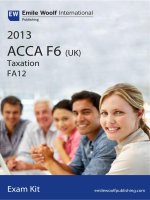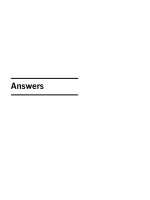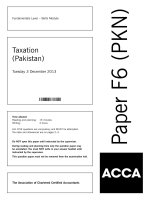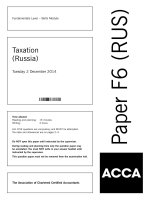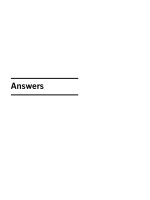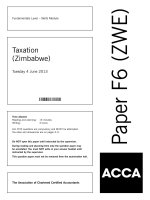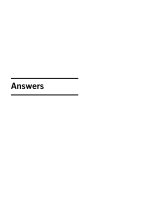ACCA f6 taxation south africa 2013 dec answer
Bạn đang xem bản rút gọn của tài liệu. Xem và tải ngay bản đầy đủ của tài liệu tại đây (180.63 KB, 9 trang )
Answers
Fundamentals Level – Skills Module, Paper F6 (ZAF)
Taxation (South Africa)
December 2013 Answer
and Marking Scheme
Marks
1
Established Tree Fellers Ltd
(a)
Outstanding contract fees
The definition of gross income requires the inclusion of all amounts which are received or accrued in cash or
otherwise in the particular year of assessment, other than amounts of a capital nature.
1
In this case, as the R2,000,000 pertains to fees for services rendered, the amount is not of a capital nature
and is received as ‘cash’.
½
The issue is therefore whether or not the R2,000,000 can be considered to be ‘received’ or ‘accrued’ for the
purposes of the gross income definition. For an amount to be considered ‘received’, the taxpayer must have
received the amount for its own benefit. For the amount to have ‘accrued’, the taxpayer must be unconditionally
entitled to the amount.
½
Clearly none of the R2,000,000 has been received either for the taxpayer’s own benefit or otherwise. It therefore
remains to be determined whether or not the amount has ‘accrued’.
½
With respect to both the R1,200,000 and the R800,000, it is submitted that the taxpayer is not yet
unconditionally entitled to the amount. For the R1,200,000, the taxpayer has to provide the evidence to the
customer that the damage was not as a result of its work and for the R800,000, the necessary repairs still have
to be completed.
In conclusion, the amounts totalling R2,000,000 will not be included in gross income of the 2013 year of
assessment.
(b)
½
½
1
½
–––
5
–––
Compensation payment
For an amount to be deductible, the amount must be expenditure actually incurred, in the production of income,
other than an amount of a capital nature.
It is clear that the amount has been paid and is therefore actually incurred.
Furthermore, the compensation paid to the employee’s family arises effectively from the services which had
been rendered by that employee and it is therefore submitted to be of a revenue nature.
In establishing whether or not the compensation payment is in the production of income, the taxpayer will have
to assess whether or not the risk of such an event was an inevitable concomitant of the business or was the
result of gross negligence. If the latter is shown to be true, the amount will not be deductible. If the former is
true, then the associated risk and payment linked to such risk may be considered to be in the production of
income.
While the nature of the work is dangerous, it was also stated that company safety procedures had not been
followed. It is therefore submitted that this is a case of negligence and no deduction will be permitted.
Tutorial note: The ultimate conclusion does not matter as the scenario is sufficiently vague for the discussion
to go either way. Marks should be awarded for reaching a conclusion which is consistent with the discussion.
Furthermore, the results of this discussion have to be carried through in part (c).
15
1
½
1
1
½
½
½
–––
5
–––
Marks
(c)
Income tax liability for the 2013 year of assessment
R
(i) Fee income (as per conclusion in part (a))
(ii) Compensation payment (as per conclusion in part (b)) – no deduction
(iii) Debarking machine: Capital allowance (Year 3: 20%)
Tutorial note: Section 12C – Full allowance despite use for only part
of the year.
Recoupment of allowances:
Selling price
Limited to cost price
Less tax value R1,500,000 x 20%
(allowances claimed 40%:2011; 20%:2012; 20%:2013
(as above))
Recoupment to be deferred
Capital gain or capital loss:
Proceeds
Less recoupment
Less base cost:
Expenditure less allowances permitted (1,500,000 – 1,200,000)
Capital gain to be deferred
(iv)
(v)
(vi)
(v)
(viii)
(ix)
Allowance on replacement machine: R2,500,000 x 40%
Recognised portion of recoupment of old machine: 40% x R1,200,000
Motorised chain saws: Year 2: 20% x R450,000
Graders: Year 3: R1,300,000/4 years x 5/12
Tutorial note: Non-manufacturing assets, wear and tear as per
Binding General Ruling 7 over four years.
Mobile cranes: Fully written off in prior year of assessment
Opening stock
Closing stock (at written down value)
Tutorial note: Spare parts are included in the definition of trading
stock.
Rental expense
Current year payment (1 November 2012): R500,000 x 5/12
Prior year payment (1 November 2011): R460,000 x 7/12
Tutorial note: The rental payments extend over a period of more than
six months after the end of the year of assessment, so must be spread
over the appropriate years on a time basis.
Doubtful debts
Current year: R900,000 x 25%
Reversal of prior year allowance: (R1,100,000 – R14,000 (amount
not previously in gross income)) x 25%
Bad debts written off (allowance): R250,000 – R14,000 (not
previously in income)
Other tax deductible expenses – given
Assessed revenue loss brought forward
Capital gain from deferral to be recognised: 40% x R300,000
Sum of current year capital gains and capital losses
Net capital gain
Taxable capital gain inclusion 66·6% x R120,000
Taxable income
Tax at 28%
Less provisional tax
Refund due
16
R
34,000,000
0
(300,000)
1,800,000
––––––––––
1,500,000
(300,000)
––––––––––
1
½
1
½
½
1
1,200,000
––––––––––
1,800,000
(1,200,000)
––––––––––
600,000
½
½
(300,000)
––––––––––
300,000
––––––––––
1
(1,000,000)
480,000
(90,000)
(135,417)
½
1
½
1
0
(450,000)
100,000
½
1
1
(208,333)
(268,333)
1
1
(225,000)
½
271,500
1
(236,000)
(29,350,000)
(1,200,000)
1
½
½
1
79,920
––––––––––
1,468,337
––––––––––
½
411,134
(500,000)
––––––––––
88,866
––––––––––
½
½
120,000
––––––––––
120,000
––––––––––
120,000
––––––––––
–––
20
–––
30
–––
Marks
2
Dr Joe Jordaan
(a)
Employees tax withheld and paid for the 2013 year of assessment
Cash salary R10,000 x 6
Commission from billings: 50% x R650,000
Employer contribution to the pension fund (not a fringe benefit, nor deductible as it is
not incurred by the employee)
Use of own laptop (taken into account in the personal tax calculation of Dr Jordaan only)
Free services for dental work (at the cost to the employer)
Medical contributions paid by employer R3,500 x 6
Sub-total
Contribution to retirement annuity fund:
Actual – R2,000 x 6 = R12,000 limited to greater of:
R1,750; or
R3,500 – R0 (pension fund contributions); or
15% x R26,600 (21,000 + 5,600) (non-retirement funding income)
= R3,990
Tutorial note: Note that ‘retirement funding employment income’ includes
contributions made by the employer.
Balance of remuneration
Annual equivalent on ‘monthly’ amounts – R407,610 x 12/6
Add ‘annual amounts’:
Software fringe benefit
Annual equivalent in total
Tax on R820,220 per the tables
Less primary rebate (under 65)
Less medical contribution rebate:
[R460 (member plus first dependant)] x 12
R
60,000
325,000
0
0
5,600
21,000
––––––––
411,600
Tax on R815,220 per the tables
Less primary rebate (under 65)
Less medical contribution rebate:
[R460 (member plus first dependant)] x 12
(3,990)
––––––––
407,610
––––––––
815,220
5,000
––––––––
820,220
––––––––
260,228
(11,440)
(5,520)
––––––––
241,268
––––––––
Tutorial note: Only 1 mark awarded to the above calculation. As the ‘monthly’
amounts annual equivalent is greater than the amount on which the highest
marginal rate is levied, the tax on the annual amount will be 40% of that
amount (i.e. R2,000).
Employees tax on ‘monthly’ amounts – R243,268 x 6/12
Add tax on annual amounts: R260,228 – R258,228
Employees tax withheld and paid to SARS
17
½
½
½
½
½
½
½
(5,520)
––––––––
243,268
––––––––
258,228
(11,440)
Tax liability for total annual equivalent
½
½
121,634
2,000
––––––––
123,634
––––––––
1
1
1
½
½
½
1
½
½
–––
11
–––
Marks
(b)
Provisional tax liability for the 2013 year of assessment
R
Employment
Cash salary
Commission from billings
Employer contribution to pension fund
Free services for dental work
Medical contributions paid by employer
Sub-total of items as per part (a)
Software licence
Wear and tear on laptop computer (permitted for employed as well as self-employed
persons) – R16,000/3 years x 8/12
Own practice
Fee income
Conversion costs
Tutorial note: The building is commercial (not manufacturing) and neither new
nor unused, so no allowance is available.
Dental equipment: R1,000,000/5 years x 5/12 (from date trade commenced)
Interest expense: R50,000 x 30% (business portion)
Rates, water etc
Tutorial note: Pre-trade expenditure may be claimed when the trade
commences, so pre and post-trade expenses can be combined.
Contribution to retirement annuity fund:
Actual – R12,000 plus R10,000 x 6 = R72,000 limited to greater of:
R1,750; or
R3,500 – R0; or
15% x R173,711 (558,711 –60,000 – 325,000)
(non-retirement funding income) = R26,057
Less medical deduction:
Employee contributions (actual and deemed) R3,500 x 12
Reduced by 4 x rebate of R5,520 (see part (a))
Qualifying contributions
Add other qualifying medical expenses:
Costs incurred
Qualifying medical costs
Reduced by 7·5% of R532,654 (taxable income before the deduction)
Taxable income
Second provisional payment: 90% of R532,654
Tutorial note: Where earnings are less than R1 million and there is no basic
amount, the estimate for the taxable income on which the provisional payments
are made must be at least 90% of the actual taxable income.
Tax per the tables
Less primary rebate (under 65)
Less medical rebate
Total normal tax
Less employees tax (from part (a))
Second provisional payment required
18
R
60,000
325,000
0
5,600
21,000
––––––––
411,600
5,000
(3,556)
½
½
1
280,000
0
½
½
(83,333)
(15,000)
(36,000)
1
1
½
––––––––
558,711
½
(26,057)
––––––––
532,654
1
42,000
(22,080)
––––––––
19,920
1
1
2,000
––––––––
21,920
(39,949)
––––––––
½
0
––––––––
532,654
––––––––
479,389
––––––––
126,786
(11,440)
(5,520)
––––––––
109,826
(119,430)
––––––––
0
––––––––
½
½
½
½
½
–––
12
–––
Marks
(c)
Normal tax liability for the 2013 year of assessment
R
486,711
––––––––
129,349
(11,440)
(5,520)
––––––––
112,389
(119,430)
0
––––––––
(7,041)
––––––––
Taxable income (full amount (from part (b))
Tax per the tables
Less rebate (primary only as less than 65 years of age)
Less medical rebate
Total normal tax
Less employees tax (from part (a))
Less provisional tax (from part (b))
Refund due
3
(a)
½
½
½
½
–––
2
–––
25
–––
Emily Woodson
(i)
Taxable capital gain on February 2013 disposal
R
Deemed proceeds (market value)
Base cost:
Valuation date value:
20% x (Proceeds less post-valuation date expenditure)
20% x (R2,200,000 – R55,000 – R100,000)
Time apportioned base cost:
B = R530,000
A = R55,000
R = R2,200,000 – R100,000 (selling costs)
Therefore: P = R x B/(B + A) =
N=
T=
Time apportioned base cost:
Y = B + ((P – B) x N)/(T + N)
Choose time apportioned base cost
Post-valuation date expenditure: R100,000 + R55,000
Capital gain before donations tax
Portion of donations tax to add to base cost:
M = Market value of the asset
A = Base cost before donations tax R758,761 + R155,000
D = Donations tax payable
Y = (M – A) x D/M
Capital gain reduced by the increase in base cost
Less annual exclusion
Aggregate and net capital gain
Taxable capital gain: R1,080,843 x 33·3%
Tax at 40%
(ii)
R
2,200,000
1
409,000
1
530,000
55,000
2,100,000
1,902,564
2
12
½
½
1
1
½
½
758,761
(758,761)
(155,000)
––––––––––
1,286,239
2,200,000
913,761
300,000
(175,396)
––––––––––
1,110,843
(30,000)
––––––––––
1,080,843
––––––––––
359,921
––––––––––
143,968
1
½
1
½
1
½
1
½
½
½
–––
13
–––
Net cash flow from transaction
R
Total payable:
Donations tax
Capital gains tax (from part (i))
Selling costs
300,000
143,968
100,000
––––––––
543,968
585,000
––––––––
41,032
––––––––
Proceeds received
Net cash inflow
19
½
½
½
½
–––
2
–––
Marks
(b)
Jeff Wooodson
Aggregate gains for the 2013 year of assessment
R
(i)
The recreational boat is not a personal use asset (> 10 metres) but as the
disposal results in a capital loss (of R190,000) it will be disregarded.
(ii) The car is a personal use asset, so the gain or loss is disregarded.
(iii) The coin collection is a personal use asset, so the gain or loss is disregarded.
(iv) The gold Kruger rands are neither a personal use asset nor currency, so the
capital gain is both taxable and aggregated.
Less annual exclusion
Aggregate capital gain or capital loss
4
0
0
0
20,000
–––––––
20,000
(30,000)
–––––––
0
–––––––
1½
1
1
1
½
–––
5
–––
20
–––
Safari (Pty) Ltd
(a)
A value added tax (VAT) invoice should contain:
The words ‘tax invoice’ in a prominent place
The name, address and VAT registration number of the supplier
The name, address and VAT registration number (where registered) of the recipient
The individualised serial number and date of issue of the invoice
A full and proper description of the goods (indicating where applicable second-hand goods) or services supplied
The quantity or volume of the goods or services supplied
Either: the value of the supply, amount charged and the consideration;
or: where the tax fraction is applied, the consideration and either the amount of the VAT or that it includes VAT
and the rate charged
½ mark per item, maximum
20
3
–––
Marks
(b)
Input/output value added tax (VAT) effects
Input
R
(i)
(ii)
(iii)
(iv)
(v)
(vi)
(vii)
(c)
Tours sold – 100% of the tours are a VATable supply at the standard
rate: R3,000,000 x 14/114
Commercial accommodation from a vendor – VAT charged: R500,000
x 14/114
Residential accommodation is an exempt supply and no VAT should
have been charged and so no VAT is claimable.
First delivery vehicle: this is not an instalment sale agreement as the
period is less than 12 months.
As the invoices are only issued each month for the amount due that
month, the VAT is only claimable as each invoice is issued/payment is
made. R34,000 x 2 x 14/114
Second delivery vehicle: this is an instalment sale agreement. VAT is
based on the cash cost (excluding finance charges) – R560,000 x
14/114
The full VAT input is claimable on delivery.
Despite the vehicle being a second-hand good from a non-vendor, no
notional input can be claimed as the vehicle is a motor car as defined
for VAT purposes and the input is therefore denied.
The party would constitute ‘entertainment’ and so the tax input would
be denied.
Bad debts written off result in a reversal of the output VAT – R50,000
x 14/114
The rental service for the R35,000 payment made on 6 June was
rendered in May and the VAT input should have been claimed in that
VAT period (irrespective of payment date).
Rentals for the use of the premises during the VAT period (i.e. June and
July) – R35,000 x 2 x 14/114
Output
R
368,421
1
61,404
1
0
1
½
8,351
1
68,772
1
0
1
0
1
6,140
1
0
1
8,596
––––––––
153,263
––––––––
––––––––
368,421
––––––––
The VAT payment due to SARS for the VAT period June to July 2013 is R215,158.
The VAT return must be filed by the last business day of the month following the end of the VAT period.
Payment (if due) must be made by the same date.
½
–––
10
–––
½
1
½
–––
2
–––
Tutorial note: Payment means that the amount must have been cleared in the SARS bank account.
15
–––
5
Theoretical questions
(a)
‘Practice generally prevailing’ has been incorporated in the Tax Administration Act. As a result, official practices
found in Binding General Rulings, Interpretation Notes, Practice Notes or written statements by a senior SARS
official or the Commissioner are binding unless legislation is passed to override that practice.
(b)
The types of tax contained in the Income Tax Act are:
–
–
–
–
1
1
1
–––
3
–––
Normal tax
Turnover tax
Donations tax
Any withholding tax (dividends tax; employees tax; withholding tax on royalties; withholding tax on
entertainers and sport spersons etc).
½ mark per item, maximum
Note to marker: Listing multiple withholdings taxes scores a maximum of ½ mark.
21
2
–––
Marks
(c)
(d)
A taxpayer who has submitted a return which is not subject to dispute or audit, must retain their records for a
period of five years from the date of submission of the return.
Zero rated supplies are considered to be taxable supplies carrying value added tax (VAT) at the rate of 0%.
Therefore, the vendor can claim VAT inputs against the nil output.
Exempt supplies are supplies on which VAT may not be charged and against which any related VAT input cannot
be claimed.
(e)
The partnership itself should register for value added tax (VAT) as the VAT Act treats the partnership enterprise
as a person.
22
1
–––
1½
1½
–––
3
–––
1
–––
10
–––
